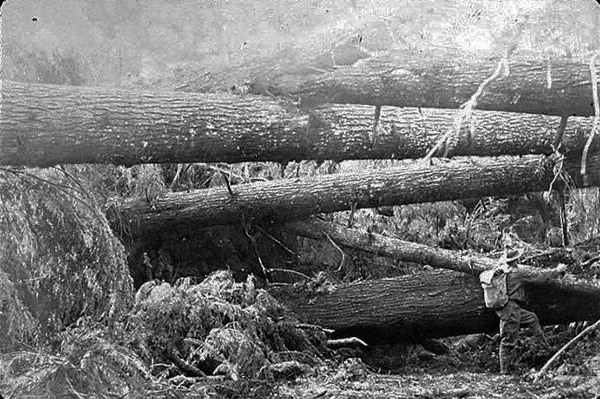People love to talk about the weather. People talk about the weather on the phone and in person. Friends and family talk about the weather before they discuss what’s new. Co-workers talk about the weather before starting a hard day of work.
Even strangers discuss the weather.
Why do we talk about it? Is it because we have no control over it? Oftentimes residents of the West End have found themselves at the mercy of the power of the weather.
On Saturday, Jan. 29, 1921, a weather system, like none since, hit Clallam County. “The Big Blowdown” was a gale that packed 100-150 mile an hour winds.
It swept in over an area 70 miles long by 35 miles wide though the dense timber stands of the West End. In its wake it left an estimated 6 billion board feet of timber on the ground.
Roads were blocked for weeks, homes, barns and vehicles were destroyed, livestock and wildlife were killed. Unbelievably no loss of human life was reported.
It was almost four days after the disaster before the extent of the damage trickled out from the isolated West End. It took weeks for Westenders to climb, cut and pick their way out over logs stacked like a jumble of giant pick-up sticks.
Every road, trail and highway was covered with debris, in many places those clearing the road way had to work down to even find the gravel road bed. It was reported it took three days to clear the road from the north end of Forks to the Calawah bridge.
A count of downed trees over the roadway from Beaver to Fairholme tallied 1,700. The trees stretched across the highway having shattered the crown of the road, their roots tearing up huge sections of the roadside as they fell.
In a Port Angeles Evening News interview from June 27, 1966, then 92-year-old West End pioneer Guy Lesure recalled the events of the “Big Blowdown.” In January 1921 Lesure’s occupation was cruising for the Lacey Timber interests.
Mrs. Lesure was in charge of the central exchange for the phone company. The service was installed in the Lesure home.
Radio and television were yet to be the source for news so the telephone served that purpose. Just after noon calls started pouring in that the barometer was plummeting, horses were squealing and cows bellowing and the sky was looking mighty nasty.
Then at 3:30 p.m. the hurricane struck with awesome force. The wind shrieked, debris flew and huge trees snapped like dry macaroni. At the Sappho store it took five men to keep the door from slamming open.
A Port Angeles-Western locomotive shuddered to a stop at a partial clearing near the Soleduck River bridge. The train consisted of loaded flat cars, a passenger coach and a car used for dining. Four women and several children were eating in the dining car. As the train stopped a tree crashed across the car cutting it in two.
Miraculously none of the diners even suffered a scratch. A mail carrier, alarmed by the intensity of the storm, parked his Model T Ford on the road and sprinted for the Calawah bridge just in time as a huge tree smashed the car into the ground.
As I am writing this the barometer is dropping and off in the distance I think I hear a cow bellow. Hopefully, the “Big Blowdown” will forever remain the greatest disaster, in recorded history, to ever hit the West End.


